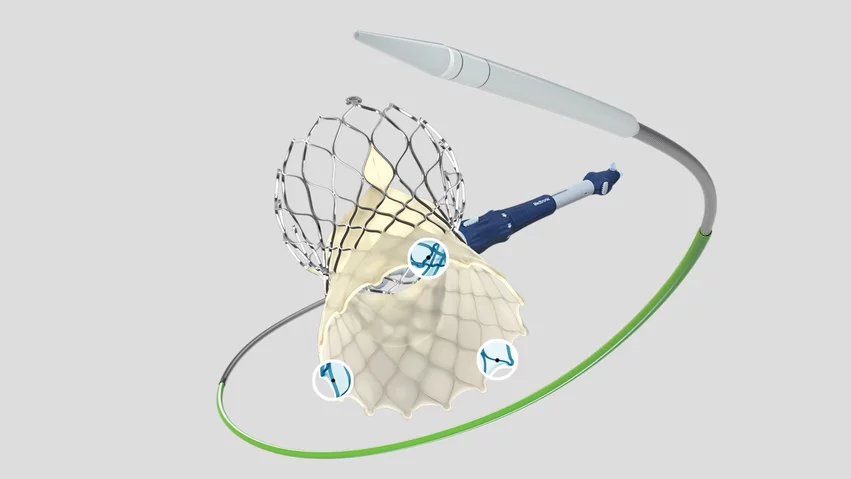‘A huge victory for patient care’: Next-gen TAVR valve helps cardiologists target more patients
University Hospitals Cleveland Medical Center (UHCMC) is home to a busy transcatheter aortic valve replacement (TAVR) program that treats more than 400 patients per year—and their cardiologists and surgeons are leading the way with leading edge technology, implanting the world’s first EvolutTM PRO+ and EvolutTM PRO+ 34-mm TAVR valves.
UHCMC also was an early adopter of the new EvolutTM FX TAVR valve, which Medtronic fully launched in September 2022, and the hospital’s clinicians agree it’s a key step forward in the treatment of symptomatic severe aortic stenosis (AS).
“The Evolut FX system is an improvement over previous Evolut system devices and it delivers better overall results to our patients,” says interventional cardiologist Guilherme Attizzani, MD, director of UHCMC’s valve and structural heart center and a professor at Case Western Reserve University. “It is an ideal solution for a majority of our patients.”
Excellent valve durability1 & improved commissural alignment2
Attizzani, a veteran interventional cardiologist who has personally implanted and overseen more than 3,000 TAVR procedures, says the biggest strength of the supra-annular, self-expandable Evolut valve is its durability advantage over SAVR in high- and extreme-risk patients.1 This allows clinicians to consider treating younger patients with more confidence than prior TAVR valves.
“When you’re treating a younger AS patient, you can’t just think about short-term outcomes,” he says. “You also have to consider the many years that will occur after treatment as well. A patient isn’t a photo that stays in one place—a patient is a movie that is playing right in front of your eyes.”
The Evolut valves have also shown promising results in low-risk patients, a key point to consider when treating younger patients.
Attizzani also notes: “Many younger TAVR patients are still very active. They practice sports, they run, they swim. These people often require a valve that can offer the largest effective orifice area possible and deliver excellent hemodynamics3 to support their active lifestyle.” This is another reason why the Evolut family of valves fills TAVR operators with a high level of confidence.
Clinicians already have years of data supporting the durability of the CoreValveTM/EvolutTM platform. The data from the combined high risk and SURTAVI trials, for example, found that valve durability five years after TAVR was significantly better than valve durability five years after surgery.1 A key piece of the Evolut FX’s success, Attizzani says, is that it takes the existing Evolut platform and brings in additional features that should make long-term durability an even bigger strength.

“When you’re treating a younger aortic stenosis patient, you can’t just think about short-term outcomes. You also have to consider the many years that will occur after treatment as well. A patient isn’t a photo that stays in one place—a patient is a movie that is playing right in front of your eyes.”
- Guilherme Attizzani, MD, director of the valve and structural heart center at University Hospitals Cleveland Medical Center
One of the more substantial updates on the Evolut FX valve is the addition of three radiopaque markers designed to assist with commissural alignment. These markers, visible on fluoroscopy (X ray), help operators feel confident the valve is properly implanted.
“Commissure alignment is really important because it helps ensure that the coronary artery can still be accessed if necessary,” Attizzani says. “Our colleagues in cardiac surgery have been looking at commissural alignment forever. They are able to see exactly what they are doing, so they can make sure they are not putting the commissural posts in front of the coronary ostia. That’s harder to visualize with an interventional procedure, and it’s something we never even really worried about in the early days of TAVR. Now, we have a way of visualizing that the valve is being implanted exactly where it belongs.”
Early evidence suggests the new radiopaque markers are making a big difference2. In addition, a small study led by Attizzani confirmed the new design is making a significant impact on patient care.4
Additional research Attizzani presented at TCT 2023 in San Francisco provided even more evidence of the markers’ positive effect. According to data from 50 patients treated with the Evolut FX valve, all patients exhibited commissure alignment by angiogram, while commissural alignment determined by post-TAVR CT was seen in 93.5% of patients, and coronary alignment was seen in more than 80%. Coronary artery cannulation post TAVR was a success in 100% of patients.6 This data is very important, he explained, because younger, lower risk patients undergo TAVR.
“These improvements really help us with patient selection,” he adds. “We are in the era of TAVR customization. There is a growing number of different TAVR valves on the market, and we need to be able to choose the appropriate valve and appropriate procedure for every patient. In the early days of TAVR, maybe there was less time spent comparing the valves and looking at every minor detail. Things have changed, though, and things like patient anatomy and commissure alignment are part of the high-level discussions we have.”
Easy and straightforward to use
One key factor TAVR programs consider when selecting valves is how challenging they may be to implant. If an operator has only performed a handful of TAVRs in their career, can they successfully complete the procedure? Or is it complex enough that only a more experienced user should be using the device?
With the Evolut FX system, Attizzani says, operators with varying levels of experience should be able to perform one successful TAVR after another. The cusp overlap technique helps limit the risk of a permanent pacemaker implantation, for example, and the consistent deployment minimizes interactions between the TAVR system and the guidewire. The Evolut FX valves were designed specifically to minimize canting, he says, thus resulting in a much more even deployment than users may have experienced with older-generation devices.2
“The ease of use of TAVR valves has definitely increased over time,” Attizzani says. “Even centers with a little less experience than others should still have a lot of success using the Evolut FX system.”
Strong outcomes, again and again
And most important, Attizzani is quick to praise the patient outcomes and consistent durability from the CoreValve platform up to 10 years. He and his team have already performed more than 230 TAVR procedures using the new valve, and the group has no plans to slow down that pace.
“We have as much experience with this valve as any other centers in the country, and we’ve had really good outcomes so far,” Attizzani says.
In addition to its ability to limit deterioration, the very structure of the Evolut FX system is associated with certain benefits that help ensure patient outcomes will be strong. Evolut TAVR has long been associated with key benefits among patients with severe AS, including a reduced risk of disabling stroke, bleeding complications, atrial fibrillation, and acute kidney injury, but have higher paravalvular regurgitation and pacemaker rates compared to traditional open-heart surgery.5
The structure of the Evolut platform also is associated with a limited risk of patient prosthesis mismatch (PPM), a complication that has hounded TAVR operators since the procedure’s beginning.3
“PPM is a well-known issue with surgical valves,” he says. “If the valve isn’t of sufficient size, it may not enable enough blood flow. The hemodynamics of the Evolut platform can limit risk of PPM.”
Overall, the consistently positive outcomes associated with Evolut FX valves have led Attizzani and his team at UHCMC to feel comfortable implanting TAVR valves in a wider, more dynamic patient population than ever before.
“There have been certain patients who, in the past, maybe I would have not thought TAVR was the best choice,” he says. “However, the Evolut FX system has overcome some of the limitations of the previous generation of TAVR systems. We feel like we can treat more patients than ever and achieve consistent, reproducible results while we do it. It’s a huge victory for patient care at our center.”
See important safety information here.

